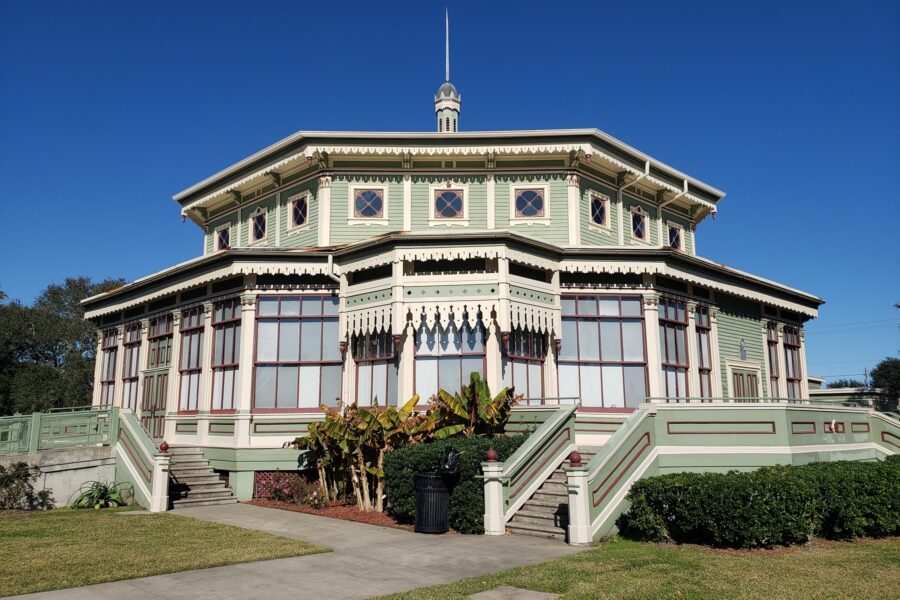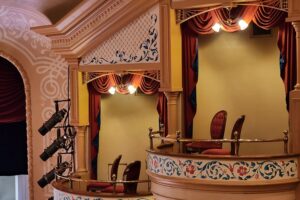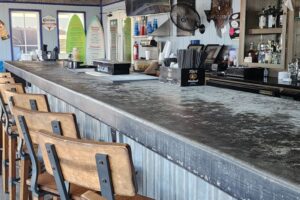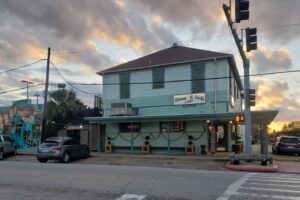Standing here, looking at this strange old octagonal structure with its slender cupola rising to touch the sky, I’m in awe. The sheer beauty of the day takes my breath away. How can a sky be this blue? This intense? This cloudless? The Garten Verein in Kempner Park glows beneath its azure canopy.
Kempner Park
The accidental discovery of the pale green pavilion is a remembered event of many years ago. Seeing it in passing, we were only slightly curious about its history. There was no Google. No Internet. And, we were in a hurry. Earlier this week we remembered the odd-shaped building and made a point to search for it. Hidden in one of the old residential sections in Galveston, we discovered it is part of a small tree-shaded park.
Now, curious at heart, I stand at the front gates leading to the old building trying to discern who what and why. The imposing gate posts say that Kempner Park is dedicated in memory of a long list of Kempner’s. But I still don’t know much or why this wonderful old building is here in the middle of things.
Garten Verein
Michael climbs the steps leading to a set of locked doors, head tilted back, he reads a plaque. When I join him, I discover the name Garten Verein and a bit more. My curiosity is almost satisfied. For such a small plaque, someone was able to squeeze in a lot of words.

“In design of a Teutonic club, all stockholders were of German descent. Center for city’s social life 1876-1823. Complex had an octagonal dance pavilion, tennis courts, bowling and tenpin alleys, bandstand, fountains. The complex was site of Galveston’s first underground electrical conduits. When corporation was dissolved, Stanley E. Kempner bought the property and gave it to the city for park use.”
Based on what I read, I realize that all those Kempner’s listed on the gate posts must be relatives of Stanley Kempner. I can tell a get-together with Google is in my future. Another plaque notes that the octagonal pavilion survived the infamous 1900 hurricane. This old pavilion is beautiful no matter what its story.
The Grounds
Surveying the grounds, we notice numerous picnic tables, several park benches, and a beautiful old fountain. A group of six sit at one of the tables having a friendly conversation as they munch away on a picnic feast. Leaving the porch, Michael and I take a wide path leading to the rear of the Garten Verein. Passing a stately pergola as we walk, we stop in front of one of the bark benches. The bench is positioned so that it is sunny enough for me and shady enough for Michael. Deciding to sit for a while, we inhale this tiny oasis of calm.


I am not a great judge of acreage, so I’m not sure if we are sitting in the original 5-acres or if it has shrunk. The one thing I do know is this is a beautiful shady refuge where it would be easy for a Galvestonian to hide from the hustle and bustle of the tourist deluge that at times overtakes this historic old town. And—a great place for me and Michael to have a spur-of-the-moment picnic.
The Rest of the Story
Garten Verein
The Garten Verein (garden society or garden club) was founded in February 1876 by a group of German businessmen who purchased the five-acre homestead of Robert Mills, a prominent Galveston businessman. Using the Mills’ former home as their clubhouse, they implemented the remainder of their design of a Garten Verein. The dance pavilion that remains standing was built in a Teutonic style as the focal point of the social club. The stockholders, originally required to be German or of German ancestry, decided at some point, to allow other individuals to petition for membership. The social club consisted of a clubhouse, dance hall, lawns, gardens with walkways, bowling alleys, tennis courts, croquet grounds, and playgrounds.
The social season opened each April; concerts and dances were held throughout the spring and summer months, and people used the grounds for picnics and gatherings. Because the Garten Verein was the first site in Galveston with underground wiring, it allowed hundreds of lights to illuminate their fountain and the surrounding pond that contained dozens of goldfish varieties.


As stated on a small plaque by the front door, the beautiful dancing pavilion that still stands was the only structure to survive the 1900 Storm. The storm caused debris to be piled up to ten feet high in the park. The flagpole atop the pavilion broke off and was not replaced. Instead, a “cute little cupola” was added.
Endings and Beginnings
After World War I, when overt Germanness had fallen out of fashion in America, a steady decline in membership in the Garten Verein led the members that remained to sell the property in 1923 to Stanley Kempner. Kempner donated Garten Verein to the city for use as a park dedicated to his parents, Eliza Seinsheimer and Harris Kempner. After a 1981 fire, the pavilion was restored; in 1998, the entirety of Kempner Park was refurbished to commemorate the 50th anniversary of the Harris and Eliza Kempner Fund.
Wedding, Family Reunions or Meeting Venue
Today, the Garten Verein is managed by the Galveston Historical Foundation and is available for rentals. Visitors can enter the park during daylight hours to get a closer look at the beautiful Garten Verein pavilion, have picnics, or enjoy the peace and quiet it offers.
To find out more, click on any of the following links:
https://www.galveston.com/weddings/wedding-venues/gartenverein/
https://www.herecomestheguide.com/wedding-venues/texas/1880-garten-verein
https://www.visitgalveston.com/directory/garten-verein/









Leave a Reply
Your email is safe with us.